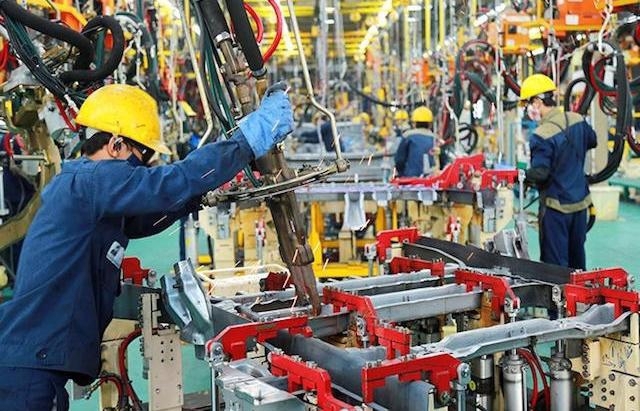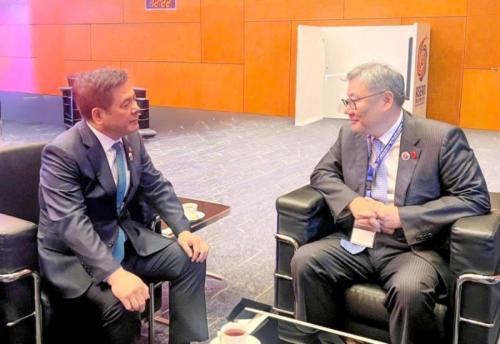Northern Vietnam becomes center of FDI attraction
Vietnam’s northern localities have emerged as popular destinations for foreign investors seeking opportunities and possible partnerships.
Figures from the Foreign Investment Agency (FIA) at the Ministry of Finance (MoF) show that total registered FDI in Vietnam reached over $26.14 billion in 2,534 new projects during the first eight months of 2025. Among the Top 10 cities and provinces attracting the most FDI are five in the country’s northern region: Bac Ninh, with over $4.68 billion, Hanoi with over $3.8 billion, Hai Phong with $1.71 billion, Ninh Binh with $1.53 billion, and Hung Yen with $1.39 billion. These numbers reflect a trend of foreign investors flocking to the north with long-term confidence in the region’s business environment, infrastructure, and workforce.
Rising star
One notable highlight is that, in September, northern Vietnam witnessed a strong wave of major enterprises coming to conduct surveys and explore opportunities for expanding their investments.
One was Shemar Power from China, a high-tech enterprise specializing in the research, development, and production of power products made from new materials. The company is planning to build up to five factories in Vietnam, with total investment of $190 million, and has selected Bac Ninh province as its strategic investment destination. Its plans are considered an important step that further consolidates Bac Ninh’s position on the FDI map.
To implement its investment plan, Mr. Ma Bin, Founder and Chairman of the Board of Directors at Shemar Power, expressed expectations that Bac Ninh will support the company in finding suitable locations, offer it preferential tax and land policies, and provide quick guidance on the necessary investment and business procedures.
Similarly, a working delegation from the WLA Development Foundation in China also conducted a field survey in Bac Ninh to explore opportunities for cooperation in urban infrastructure and smart city development. Mr. Wu Xiang Dong, Chief Director of the WLA Development Foundation, said he greatly values the province’s potential, advantages, and strategic location, while also expressing keen interest in its orientation towards scientific and technological development and smart urban construction.
Beyond Bac Ninh, Hung Yen province has also emerged as a rising star in northern Vietnam’s FDI landscape. With a strategic location following its merger with part of former Thai Binh province, coupled with a well-developed transport and industrial infrastructure network and increasingly open investment policies, Hung Yen has quickly become a popular choice for major corporations from Japan, South Korea, Singapore, and elsewhere.
One potential investor is Haemologic Biotech from Australia, which specializes in the manufacturing of high-tech medical equipment. The company is planning to establish a factory in Vietnam to expand its scale and optimize its global supply chain, and has already conducted surveys at several key industrial parks in Hung Yen. “The development of industrial park infrastructure and supporting services in Hung Yen has created a favorable and well-coordinated environment for investors,” Mr. Michael Gallagher, Managing Director of Haemologic Biotech, emphasized.
The province is not only attracting industrial investment but has also become a destination for large-scale projects in real estate and tourism. Hung Yen was recently selected by the Trump Organization as the site for the Trump International Hung Yen project - a mixed-use complex featuring urban development, eco-tourism, and a golf course in Khoai Chau - with total investment of more than $1.5 billion, making it one of the largest FDI projects in the province to date.
Additionally, large foreign investors such as Samsung, Foxconn, Hana Micron, Canon, Goertek, Luxshare, and Amkor have also established a presence and continually expanded operations in the northern region. This not only underscores its enduring appeal for electronics and semiconductor industries but also elevates the region’s position within the global value chain.
Converging competitive advantages
Many of Vietnam’s northern localities has emerged as attractive destinations for FDI as they bring together a host of outstanding competitive advantages. With its strategic geographic location, northern Vietnam is well-positioned to connect seamlessly with global supply chains while also expanding access to international markets.
In particular, industrial infrastructure in the region has been increasingly upgraded and refined, ranging from industrial parks and economic zones to seaports, airports, and expressway networks. This provides a solid foundation not only for manufacturing activities but also for trade and exports.
According to Mr. John Campbell, Director and Head of Industrial Services at Savills Vietnam, the difference in land rentals between Vietnam’s north and south is also a decisive factor for many investors, with rentals in industrial parks in the country’s north often being significantly lower than in the south. “Beyond the advantage of more competitive land rentals, northern Vietnam is also attracting FDI flows of medium to high-tech levels, focusing on high value added sectors such as automobiles, machinery and equipment, semiconductors, electronics, and solar energy,” he emphasized.
In terms of supply, many new industrial park projects are expected to continue opening in the north in the immediate future, which is forecast to further accelerate the shift of FDI into the region, especially in high-tech manufacturing and support industries.
Alongside affordable land costs and abundant supply, well-developed transport infrastructure further strengthens the north’s competitiveness. The Northern Key Economic Region, which includes Bac Ninh and Hai Phong, enjoys a favorable location near China and northeast Asian markets. The region currently accounts for approximately 61 per cent of Vietnam’s total expressway length, highlighted by the Lao Cai - Quang Ninh Expressway spanning 600 km, which enables rapid connections between industrial parks, the capital Hanoi, and the northern border.
Beyond road networks, the network of seaports in Hai Phong and Quang Ninh, together with two international airports - Noi Bai International Airport in Hanoi and Cat Bi International Airport in Hai Phong - creates optimal conditions for supply chain development and the expansion of international trade. This comprehensive connectivity positions northern Vietnam as an increasingly important logistics hub for the region.
Moreover, many foreign investors view northern localities not only as favorable production sites but also as strategic destinations within both regional and global supply chains. As a result, FDI projects in northern localities are not limited to manufacturing but are also oriented towards establishing research and development (R&D) centers, workforce training facilities, and initiatives that generate sustainable value for the supply chain. “Locating our factory in Hung Yen will allow us to be closer to the Asian market, shorten logistics times, and enhance the competitiveness of our high-tech medical devices,” Mr. Gallagher added.
To fully leverage these advantages and continue attracting high-quality FDI, northern localities have proactively developed flexible and effective investment promotion mechanisms and policies in recent years. Local authorities have also focused on offering incentives tailored to specific industries and locations, particularly within industrial parks and technology parks, while prioritizing high-tech sectors, manufacturing and processing, high-quality services, research, and innovation.
Many northern localities are also pursuing a selective investment approach, prioritizing projects that emphasize advanced technology, environmental sustainability, commitments to technology transfer, and stronger links with domestic enterprises. This strategy not only helps northern Vietnam sustain its appeal among foreign investors but also enhances the quality, sustainability, and spillover effects of FDI inflows over the long term.
Source: Phuong Hoa





